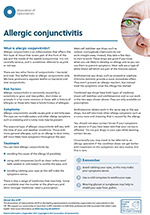Allergic conjunctivitis
Inflammation that affects the front of the eye and the inside of the eyelids
What is allergic conjunctivitis?
Allergic conjunctivitis is an inflammation that affects the thin layer of tissue that covers part of the front of the eye and the inside of the eyelids (conjunctiva). It is not normally serious, and is sometimes referred to as pink or red eye.
There are two other forms of conjunctivitis – bacterial and viral. This leaflet looks at allergic conjunctivitis only. We have produced a separate leaflet on bacterial and viral conjunctivitis.
Risk factors
Allergic conjunctivitis is commonly caused by a sensitivity to grass and tree pollen, dust mites or animals. It is far more common in those with a history of allergies or those who have a family history of allergies.
Symptoms
Allergic conjunctivitis usually causes pink or red itchy eyes. The eyes are normally watery and other allergy symptoms such as sneezing and a runny nose may be present.
The seasonal type of allergic conjunctivitis will vary with the time of year and weather conditions. Those with more general allergies, such as an allergy to dust mites, will most likely have symptoms throughout the year.
Treatment
You can treat allergic conjunctivitis by:
- Avoiding the cause of the allergy (if possible)
- Using cold compresses (such as clean cotton wool balls soaked in cold water) to soothe the eyes
- Avoiding rubbing your eyes as this will make the symptoms worse
There is also a range of medicines that may help. Some are available over the counter at the pharmacy and other stronger medicines need a prescription.
Mast-cell stabiliser eye drops such as sodium cromoglicate (Opticrom) do not work straight away. Instead, they take a few days to start to work. These drops are good if you know when you are likely to develop an allergy and so you can use them to prevent symptoms. Mast cells are a type of white blood cell which are part of the immune system.
Antihistamine eye drops such as antazoline sulphate (Otrivine-Antistin) provide a more immediate effect. They won’t prevent an allergic reaction, but instead treat the symptoms once the allergy has started.
Combined eye drops have both types of medicine (mast-cell stabiliser and antihistamine) and so can work in the two ways shown above. They are only available on prescription.
Antihistamine tablets work in the same way as the eye drops, but will also treat other allergy symptoms such as a runny nose and sneezing that is caused by the allergy.
You should not wear contact lenses if your symptoms are severe or if you have been told that your cornea is affected. Do not put drops in your eyes while wearing contact lenses.
Occasionally you may need to be referred to an allergy specialist if the condition does not get better with treatment or the symptoms are very severe, but this is rare.
Remember:
- Avoid rubbing your eyes, as this may make your symptoms worse
- Use a cold compress to soothe your eyes
- Wearing glasses or sunglasses may help to shield your eyes from pollen
Resources for your practice

You can download our patient leaflet on allergic conjunctivitis.
If you're a practitioner, we recommend that you use this information, following a suitable examination, to reinforce advice given to the patient who has symptoms of allergic conjunctivitis.
For more information on eye health, go to our For patients section.

